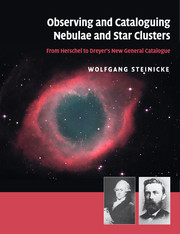Book contents
- Frontmatter
- Contents
- Preface
- 1 Introduction
- 2 William Herschel's observations and parallel activities
- 3 John Herschel's Slough observations
- 4 Discoveries made in parallel with John Herschel's Slough observations
- 5 John Herschel at the Cape of Good Hope
- 6 The time after Herschel's observations until Auwers' list of new nebulae
- 7 Compiling the General Catalogue
- 8 Dreyer's first catalogue: the supplement to Herschel's General Catalogue
- 9 Compilation of the New General Catalogue
- 10 The New General Catalogue: publication, analysis and effects
- 11 Special topics
- 12 Summary
- Appendix
- References
- Internet and image sources
- Name index
- Site index
- Object index
- Subject index
9 - Compilation of the New General Catalogue
Published online by Cambridge University Press: 06 December 2010
- Frontmatter
- Contents
- Preface
- 1 Introduction
- 2 William Herschel's observations and parallel activities
- 3 John Herschel's Slough observations
- 4 Discoveries made in parallel with John Herschel's Slough observations
- 5 John Herschel at the Cape of Good Hope
- 6 The time after Herschel's observations until Auwers' list of new nebulae
- 7 Compiling the General Catalogue
- 8 Dreyer's first catalogue: the supplement to Herschel's General Catalogue
- 9 Compilation of the New General Catalogue
- 10 The New General Catalogue: publication, analysis and effects
- 11 Special topics
- 12 Summary
- Appendix
- References
- Internet and image sources
- Name index
- Site index
- Object index
- Subject index
Summary
On coming to Dunsink Observatory in 1878, Dreyer was tasked with the completion of the Birr Castle publication. The work was finished in early 1880, whereafter he had time to focus on newly discovered nebulae. The cataloguing was done in parallel with his regular work as the assistant of Robert Ball, who was familiar with this issue, due to his own stay at Birr Castle. From 1882 Dreyer, as Director of Armagh Observatory, had complete freedom to work on a new catalogue of nebulae and star clusters.
The result was presented to the RAS in 1886 as a ‘second supplement’ to the General Catalogue, a follow-up of the GCS. It was surprising for Dreyer to learn that the society had refused his new work. However, the reason was honourable: the RAS favoured a ‘new general catalogue’ instead. It should contain all known non-stellar objects, thus being a complete new edition of Herschel's GC, which it had published in 1864. Since the bulk of the work had already been done, this was not a difficult task for Dreyer – it was carried out in Armagh within a year! The NGC contains a large number of new objects (as of December 1877) and became his most important (and most popular) work.
DREYER'S UNPUBLISHED ‘SECOND SUPPLEMENT’
After the publication of the GCS (1878) and the Birr Castle observations (1880), Dreyer recurrently scanned the astronomical journals and observatory publications for new nebulae.
- Type
- Chapter
- Information
- Observing and Cataloguing Nebulae and Star ClustersFrom Herschel to Dreyer's New General Catalogue, pp. 323 - 438Publisher: Cambridge University PressPrint publication year: 2010



